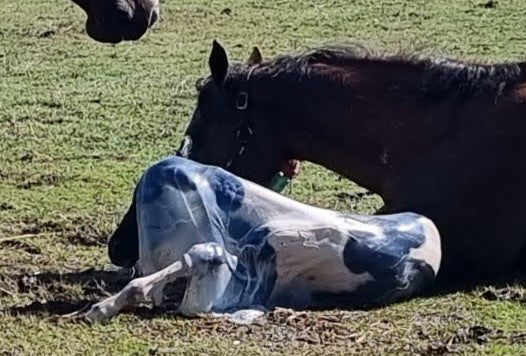If you have read our other articles and links you are as prepared as you can be.
You know what problems/symptoms to look for; the signs of foaling and what to put in your foaling kit to help you for the big moment and you've delivered your foal.
This is just the start. Now you need to monitor the foal.
The normal sequence of events can be remembered as 1, 2, 3.
1 hour after being born the foal should be able to stand.
2 hours after being born the foal should be nursing.
3 hours after being born the placenta should pass.
You then need to make sure that the foal is able to pass urine and faeces. If you see the foal straining to pass faeces it might be time to break out the enema 😱
The first couple of weeks of the foal’s life are the most precarious. The foal is born without an immune system and you need to monitor the foal for signs of infection. If the foal didn't receive high quality colostrum it may not have any antibodies. If possible, have an IgG test performed by a vet. A result below 800mg/dl will require additional colostrum or a plasma infusion.
The foal is only able to absorb critical antibodies in the mare’s colostrum within the first hours of life (up to 24 hours after birth). After that time, feeding the foal colostrum won't do any good. It's very important that the foal receives a large dose of colostrum soon after being born.
Conditions to look out for:
Neonatal isoerythrolysis (NI)
There is one time when getting lots of colostrum is bad for the foal, and that is NI. NI is a condition where the mare’s milk contains antibodies that attack - and kill - the foal's red blood cells. If left untreated the foal can die.
If the mare has previously had an NI foal then you would be extra cautious with re-breeding that mare. If the mare has no history of NI then the early symptoms of NI in the foal to watch for are: lethargy, yellow pigment around the eyes, yellow gums, red urine and elevated heart rate and breathing rate.
Treatment usually involves restricting the foal’s access to the mare - preventing it from feeding; and providing an alternative source of milk. Plasma antibodies and a blood transfusion may also be needed. If you suspect your foal has NI, call your vet.
Prevention: NI Screening test. You can test the mare’s blood in the last week or two of gestation for the presence of antibodies that may attack the foal.
Broken ribs
During birth it's possible the foal might break a rib or two. It's more likely to happen if you have pulled the foal out. A broken rib on its own isn't necessarily a problem, unless it punctures an organ. Be on the lookout for lethargy, a reluctance to move in a particular way or direction, swelling, increased or laboured breathing.
Hopefully the joy of meeting your new foal will make up for all the trauma of the previous 11 months and the intense spike of anxiety you felt as your foal came in to the world.
Foaling courses (this is not an exhaustive list):
https://www.cvmbs.colostate.edu/erlshortcourse/foaling-and-foal-care-virtual-course
https://equine-reproduction.com/education/shortcourses
https://www.csuvetce.com/catalog/equine/foaling-and-foal-care
https://onlinetraining.foaled.co.nz/
Further reading:
https://www.rossdales.com/assets/files/Rib-fractures-in-newborn-foals.pdf
https://thehorse.com/14422/colostrum-for-foals/
http://csu-cvmbs.colostate.edu/Documents/Learnfoals8-jaundicesynd-apr09.pdf

